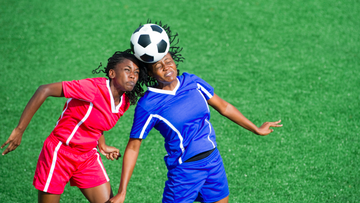Any athlete (or budding athlete) should know that performance in a game is reliant on how much training is done outside of game time. Using soccer training equipment will help boost fitness and stamina for the next game, uninhibited by poorly designed gear.
How to build fitness and stamina for your next game
Training
The most important thing to remember is to train in ways that would apply to an actual soccer game. Going for a jog might seem relevant (and it can be to help with long-term cardio) but it isn’t the be-all and end-all solution. Jogging isn’t often what soccer players do in games. There are short bursts, slides, jumps, and quick agility movements. Train in ways that simulate in-game movements.
- Try shuttle runs to mimic quick turns and following the ball.
- Do stop-and-go sprinting to get your muscles and heart used to that kind of movement.
- Do chest jumps to practice dynamic movements that will help launch you forward or up in a game.
- Run up and down stairs or ladders to increase cardiovascular endurance and work on muscle strengthening.
- Use hills to practice running or sprinting so flat ground is much easier to cross.
- Hold planks to strengthen your core and keep your movements supported in-game.
Lifestyle
Focus on how lifestyle choices might be impacting training and games. Eat quality food and get a healthy amount of sleep to provide your body with what it needs after a hard game or a tiring training session.
Aerobic versus anaerobic training
Aerobic exercises focus on oxygen. These are the exercises that produce a consistent amount of energy, converting oxygen into energy, so it can be done for longer periods. These are cardiovascular exercises, such as swimming, jogging, or hiking. This kind of training will improve stamina.
The key is to combine aerobic training with anaerobic training since soccer has a mix of long-term and short-term energy expenditure. Just as there will be a lot of consistent running, there will also be short bursts, lunges, and slides.
Those are the kinds of actions that rely on anaerobic training which, unlike aerobic, doesn’t use air in the same way. These are exercises that will quickly expend your energy or have you holding your breath to complete them, such as sprints, lifting something heavy, or jumping high. These kinds of movements will expend energy quickly, which is why both kinds of training need to be practiced and used in-game.
Why soccer training clothes are better for practice than regular clothing
Casual shirts and shorts don’t generally use the same technology and materials that soccer training clothes do. The best training clothing will mimic the feel, performance, and qualities of what you might wear when playing a game of soccer. Regular clothes can get weighed down with sweat, shift around too much, or get torn during training. Successful training is only possible if you don’t have to focus on the clothes you’re wearing.
The best kind of training will carry players seamlessly from practice to pitch, meaning the circumstances of training must be similar and supportive of in-game scenarios, including the kind of clothing. Players must also be used to their soccer training equipment so they aren’t distracted when it comes time to perform.
Storelli has soccer training clothes that use lightweight, seamless knitting with mesh side panels for venting and quality wicking fabric to draw sweat away from the body and dry quickly. The shirts come in slim-fit styles for ease of movement.
Depending on the training environment, there are T-shirts or hoodies to choose from that offer varying capabilities for optimal training sessions. Check out the rest of your options.

